ASUS ZenBook Pro 15 UX535LI Review
ASUS seems to be at the height of success when it comes to laptops in the past few years and the company has released tons of products that have gone widely successful.
PRODUCT INFO ASUS Zenbook Pro 15 UX535LI Manufacture ASUS Available at View at ASUS
The market for mid-range laptops is highly popular these days and among various series of laptops, ASUS ZenBook laptops are the ones that are priced moderately while providing mid to high-end performance. ASUS has added a lot of ZenBook laptops in the past two years and we saw a lot of innovative features in those laptops as well.
ASUS ZenBook Pro 15 UX535LI is the latest addition to the ZenBook series and it is quite similar to UX534 in features, although the performance of the laptop has been greatly improved due to newer-generation components.
The pricing and availability of the laptop have not been disclosed by the company, although we expect it to be around $1500 mark with the default specifications. We will be reviewing this laptop in great detail today and see if it can give a strong competition against DELL, HP, and Acer.
Disclaimer: The pricing of the ASUS ZenBook Pro 15 UX535 can be different from our expected price as the product is not yet released.
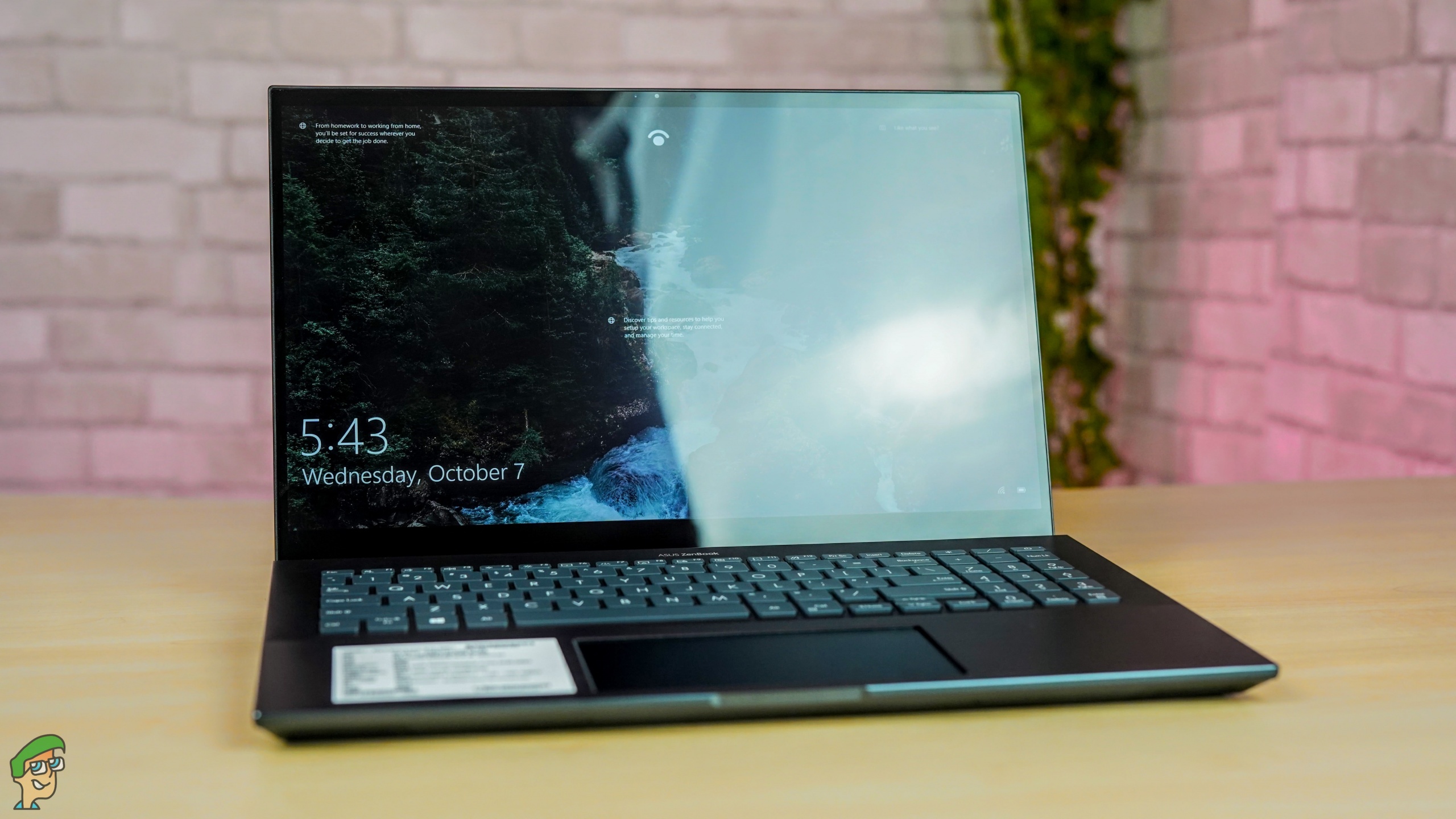
System Specifications
- Intel Core i7-10750H
- 16 GB DDR4 SDRAM
- 15.6” (16:9) LED-backlit FHD (1920 x 1080) 60 Hz touchscreen with 72% NTSC gamut and wide 178° viewing angles OR
- 15.6” (16:9) LED-backlit 4K UHD (3840 x 2160) 60 Hz anti-glare panel with 72% NTSC gamut and wide 178° viewing angles OR
- 15.6” (16:9) OLED 4K UHD (3840 x 2160) 60 Hz touchscreen with 100% DCI-P3 gamut and wide 178° viewing angles
- NVIDIA GeForce GTX 1650 Ti Max-Q design
- 1 TB PCIe NVMe 3.0 x4 M.2 SSD
- Full-size backlit with 1.35 mm key travel
- Glass-covered; intelligent palm-rejection
- Precision Touchpad (PTP) technology supports up to four-finger smart gestures
- IR webcam with Windows Hello support
- Intel Wi-Fi 6 with Gig+ performance
- Bluetooth 5.0
I/O Ports
- 1 x Thunderbolt 3 USB-C
- 1 x USB 3.2 Gen 1 Type-A
- 1 x Standard HDMI
- 1 x Standard SD card reader
- 1 x Audio combo jack
- 1 x DC-in
Miscellaneous
- ASUS SonicMaster stereo audio system with surround-sound; smart amplifier for maximum audio performance
- Array microphone with Cortana voice-recognition support
- 96 WHr 6-cell Li-ion battery OR
64 WHr 4-cell Li-polymer battery - 150 W power adaptor
- Plug Type: ø4.5 (mm)
- (Output: 20 V DC, 150 W)
- (Input: 100-240 V AC, 50/60 Hz universal)
- Dimension: 354.0 x 233.0 x 17.8 (W x D x H)
- Weight: 1.8 kg
Box Contents
- ZenBook Pro 15 (UX535LI)
- Power adapter with power cord (150 W)
- Protective sleeve (optional)
- USB Type-A to LAN dongle (optional)
Design & Build Quality
ASUS ZenBook-series laptops are well-known for their sleek looks and such is the case with the ZenBook Pro 15 UX535LI. The laptop is definitely not the slimmest and judging by just the specifications of the laptop, one can assume that it is going to be a pretty hefty laptop, however, it is a lot slimmer than what you would imagine. The laptop is available only in a single colour; Pine Grey, which would surely suit a professional environment.
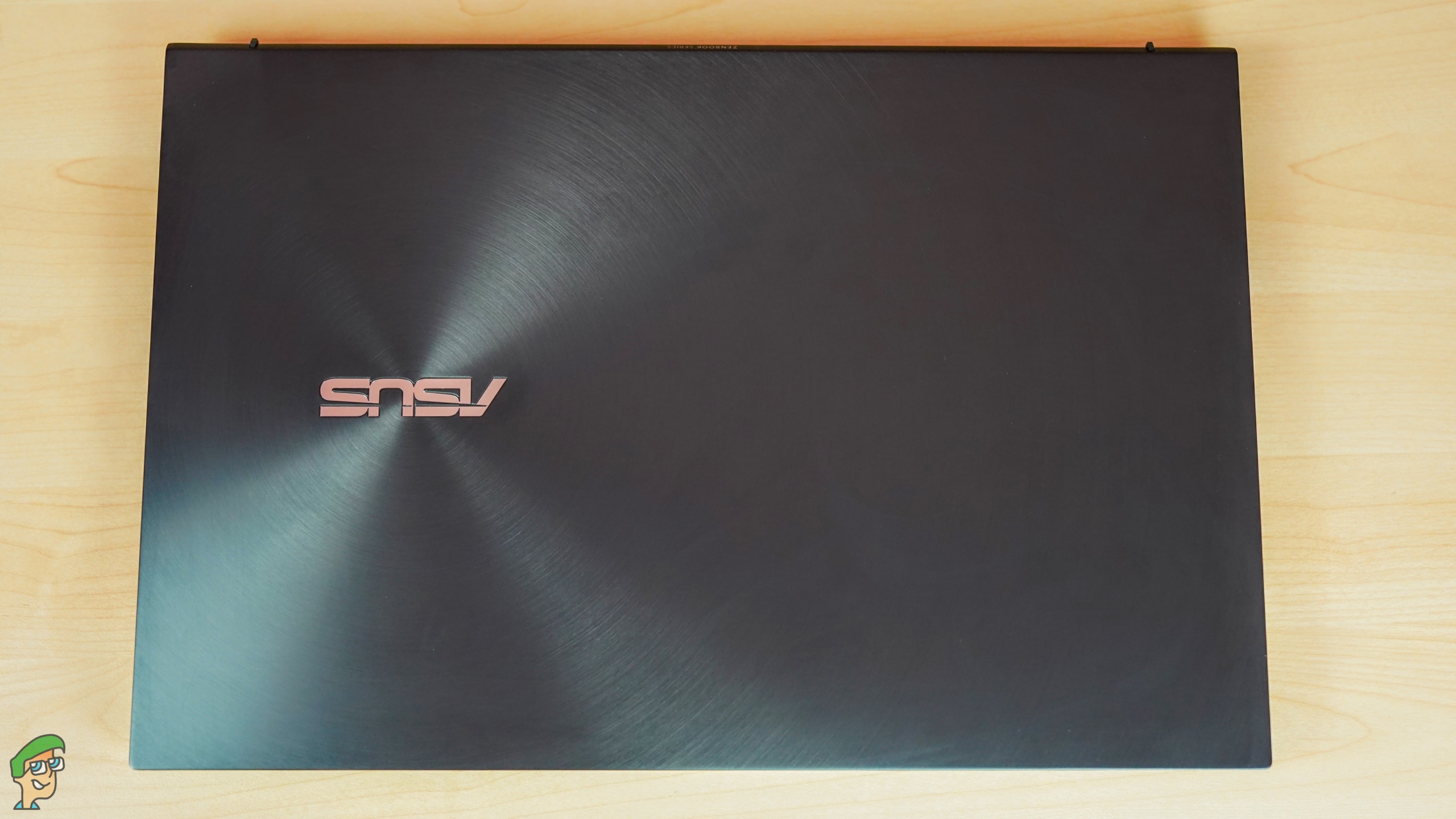
The laptop provides an all-aluminium build, that could be expected at this price point. The body of the laptop is nicely balanced out by the wedgy design, which makes it feel a lot slimmer than it is. This design was also present in the previous ZenBook-series laptops. Moreover, like the previous ZenBook-series laptop, the lid of the laptop raises the bottom by a big margin that lets the laptop breath in a proper manner. There are also vents present at the back and the sides of the laptop that are used for the exhaustion of hot air.
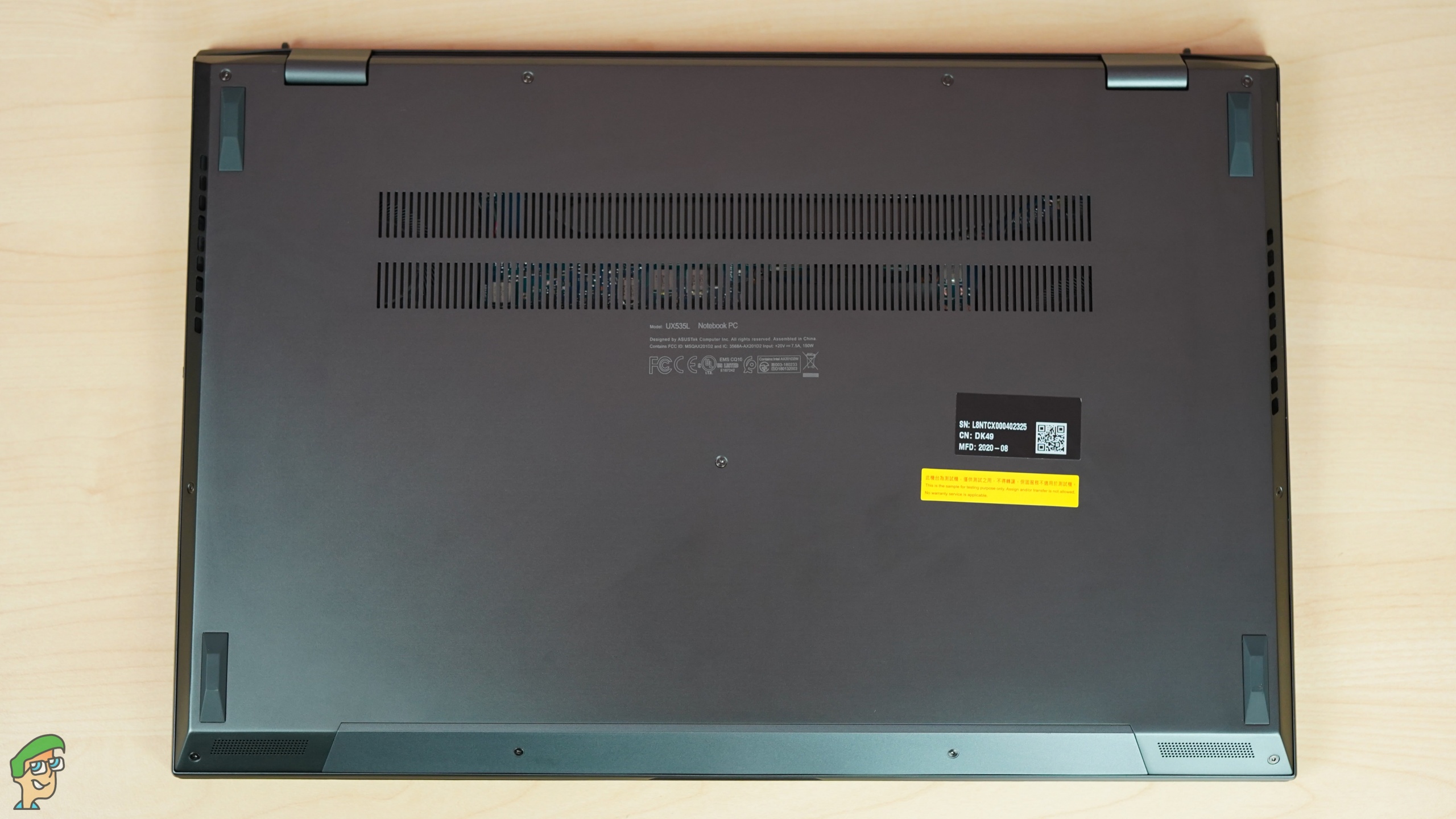
The top side of the laptop has a circular brushed pattern with grey colour, which is among the signature looks of a ZenBook-series laptop. There is written nothing except ASUS at the top and once you open the lid of the laptop, you are welcomed by an all-new bezel-less screen panel that feels really awesome and it greatly enhances the immersion of the content. The bezels are slightly bigger at the top and the bottom of the laptop while they are very slim at the sides.
There are two hinges that connect the lid to the rest of the body of the laptop but once you open the laptop, the hinges get hidden behind the body, which gives a minimalistic feel to the laptop. The advantage of the wedgy design here is also that the vents for the speaker are placed at the bottom of the laptop but the path is not obstructed by the surface.
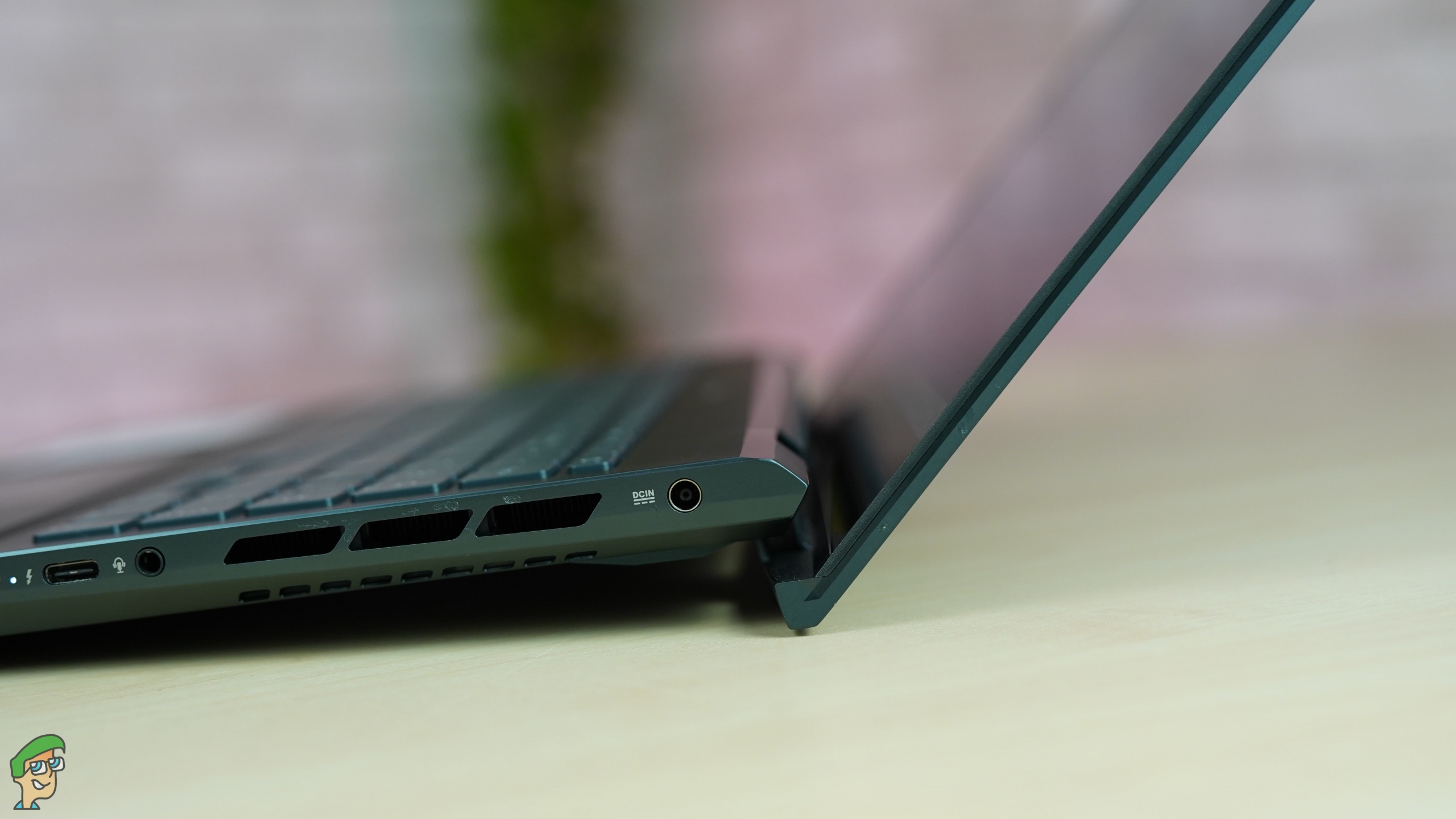
As for the inside, there is a single division between the keyboard area and the Screen-Pad area, which gives the laptop a simplistic yet elegant feel. Above the keyboard, there is ASUS ZenBook written in white colour.
Overall, the build quality of the laptop seems pretty solid at this price point and apart from being sturdy, the design of the laptop makes it great for the cooling as well.
The Processor
ASUS ZenBook Pro 15 UX535LI comes Intel Core i7-10750H. This is the latest processors by Intel for the high-end mobile machines and replaces the former Intel Core i5 9300H and the Core i7-9750H.
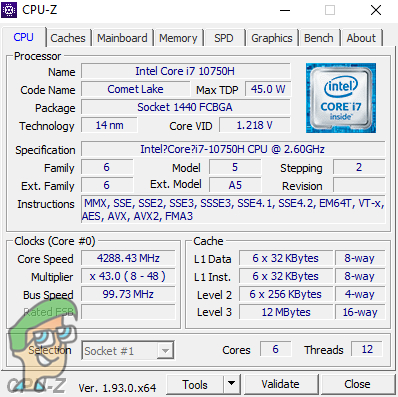
The Intel Core i7-10750H is a hexa-core processor that provides six cores and twelve threads. The Code Name of this processors is Comet Lake, which is the successor of the Coffee Lake.
The base clock of this processor is 2.6 GHz while the Turbo clock of the processor is 5.0 GHz, which is quite an impressive clock rate for a mobile processor. The processor also has a large cache size of 12 MB, where previously, these kinds of processors had a cache size of 8 MB.
The processor has a configurable TDP of 45 watts, where its TDP-Down is 35 watts. The processor utilized as much as 71 watts during full load, which is due to the Turbo clock rates. The processor also has Intel UHD graphics, having a base frequency of 350 MHz and a maximum dynamic frequency of 1150 MHz. We are not going to discuss the integrated graphics card here because this laptop came with NVIDIA GeForce GTX 1650 Ti, which is a mid-range graphics card and a lot better than the integrated graphics card.
The Graphics Card
ASUS ZenBook Pro 15 UX535LI comes with a dedicated graphics card, NVIDIA GeForce GTX 1650 Ti with Max-Q Design that has a 4 GB GDDR6 VRAM and the performance of this graphics card is lower than that of the GTX 1650 Super.

The graphics card has 1024 shader processing units, which are higher than that of the desktop GTX 1650 and lower than that of the desktop GTX 1650 Super. The base clock of the graphics card is 1035 MHz and the boost clock of the graphics card is 1200 MHz. Both of the clocks are significantly lower than that of the desktop variants or even the standard 1650 Ti mobile graphics card, which is why the performance gets hurt badly, although the temperatures of the laptop stay under control as well.
The graphics card has a similar number of Render Output Units and Texture Mapping Units as that of the GeForce GTX 1650 Ti Mobile graphics card, at 64 TMUs and 32 ROPs. The real-time performance of the graphics card is even lower than that of the desktop GTX 1650 due to the huge difference in the clock rates, which changes the resultant performance greatly.
The graphics card has 4 GB of GDDR6 VRAM, which is although the same as that of the GTX 1650 Ti Mobile, there is a bit of difference in the memory performance due to lower memory clock, as the Max-Q variant has a memory clock of 1250 MHz where the GTX 1650 Ti has a memory clock of 1500 MHz, leading to 20 percent reduction in the memory performance.
Overall, this graphics card is not so aggressive on the power consumption and that is why the thermals of the graphics card are usually under 70 degrees. The wattage of this graphics card is even lower than 50 watts and that makes it great for laptops whose cooling solution is not so powerful.
The Display
ASUS ZenBook Pro 15 UX535LI comes with three kinds of screens; a 1080P 60Hz IPS touchscreen panel having 72% NTSC colour gamut, a 4K 60Hz IPS panel having 72% NTSC colour gamut, and a 4K 60Hz OLED touchscreen panel, having a colour gamut of 100% DCI-P3. The display of this laptop has 4mm thin bezels and have a screen-to-body ratio of 88%. To be honest, this is one of the first laptops that we have seen with a bezel-less design and it surely enhances the charm of the laptop. The size of the panel is 15.6-inch, which is why the name of the laptop is ZenBook Pro 15.
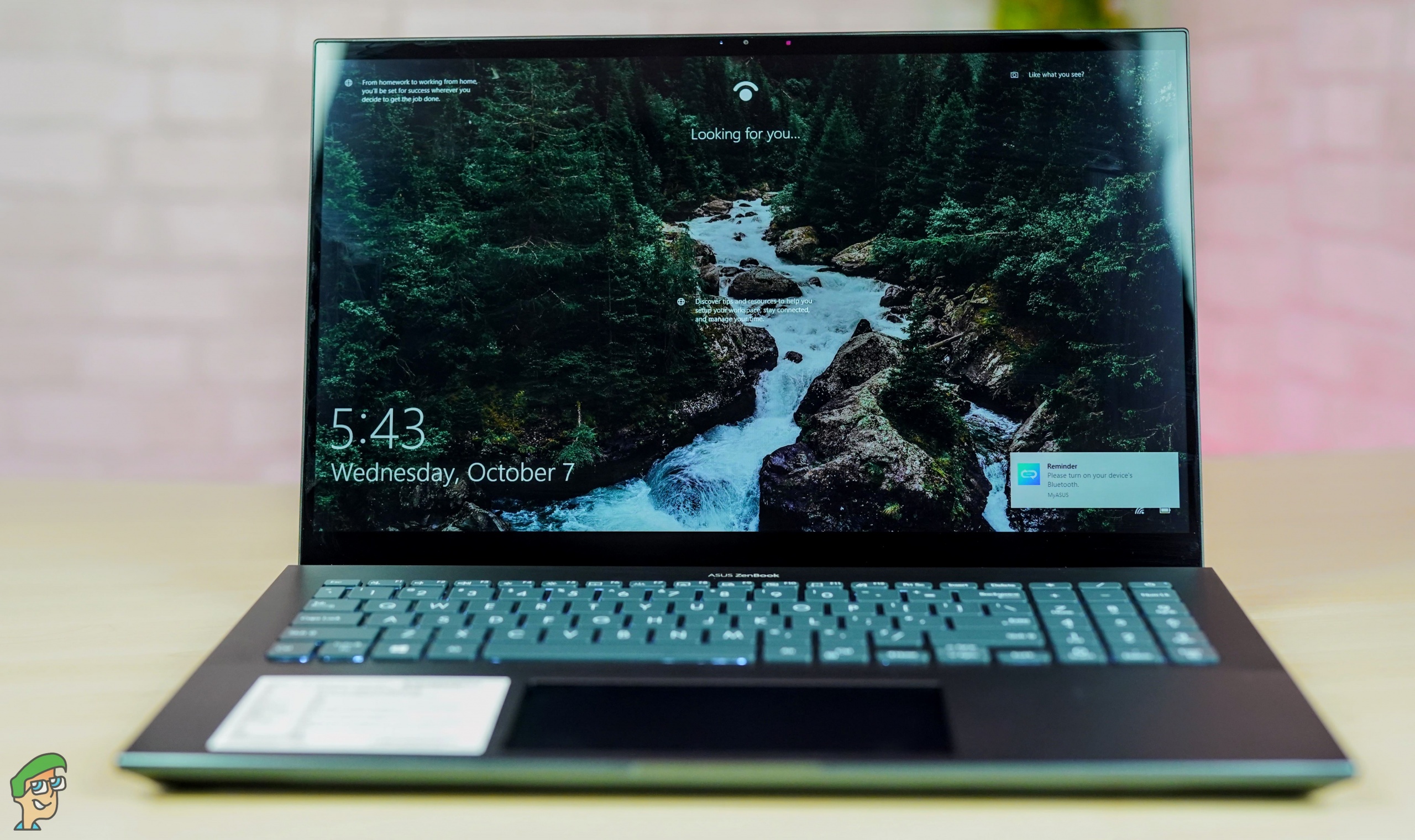
The 1080P display suits most people because, for a 15.6-inch screen, 1080P resolution is more than enough, although, for those people who want large workspace for editing purposes, 4K screen is going to be better, especially the OLED panel one because it is designed for artists who can take advantage of its high contrast and wide colour gamut.

Even though the laptop comes with pretty expensive panels, these panels are in no way comparable to the gaming panels, as both of them have different advantages. You don’t get super-fast response rates in these panels or the high refresh rates just like you don’t get wide colour gamut support in most gaming monitors.
I/O Ports, Speakers, & Webcam
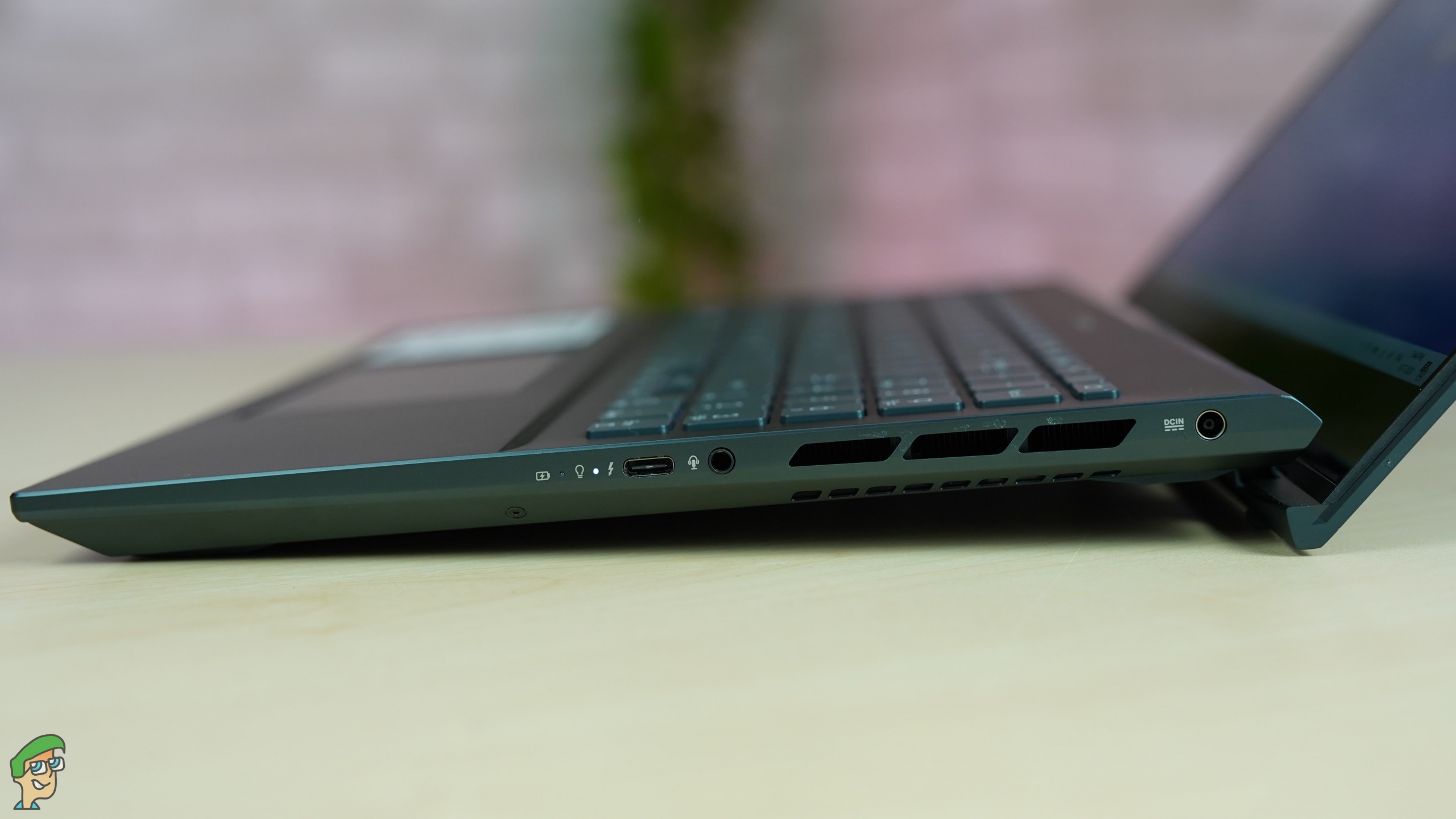
The I/O setups of laptops are getting more and more minimal and so is the case with this laptop. The laptop provides a MicroSD card reader slot, a USB 3.2 Gen1 Type-A port, and an HDMI port at the right side while at the left, the laptop offers a Thunderbolt 3 Type-C port, DC-in port, and a combo audio jack.
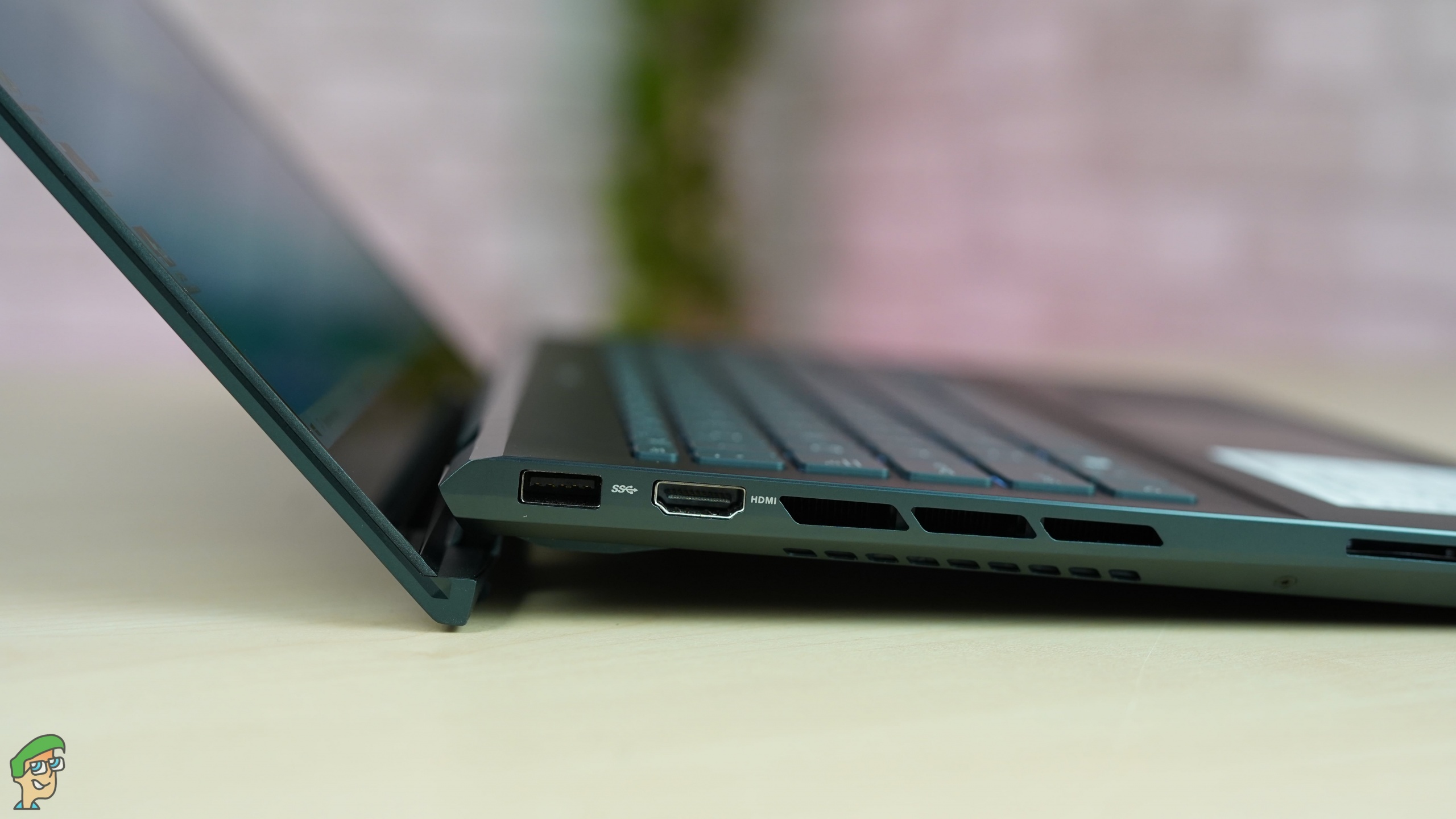
As for the speakers, the vents of the speakers are located at the front bottom of the laptop and there are two stereo speakers that support the ASUS SonicMaster audio system with surround sound as well that seem to be quite similar to the speakers ASUS is using in other ZenBook-series laptops.
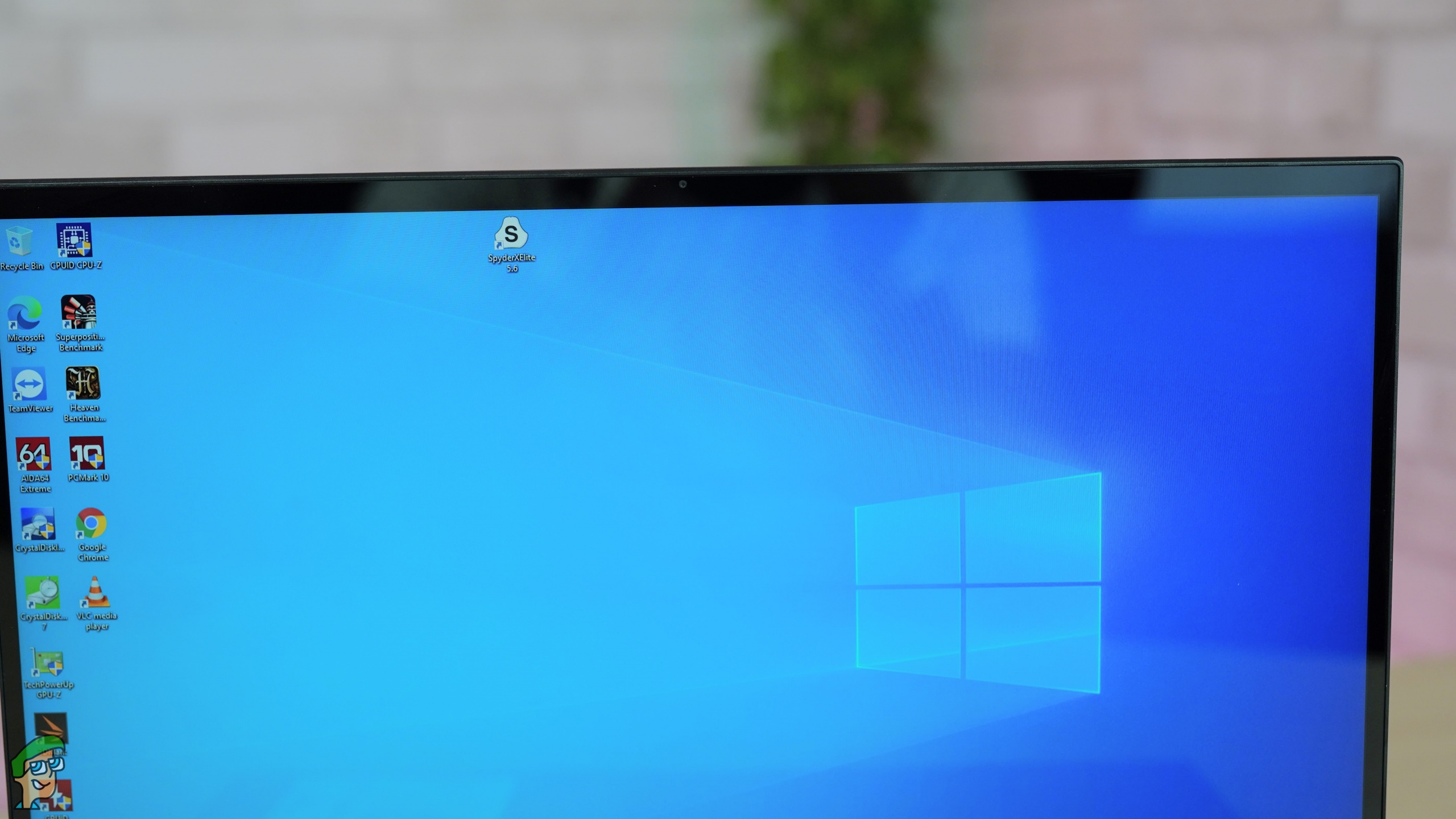
The webcam is present at the top of the screen lid, which is considered the best position for a laptop, as it gives the user a lot of control in adjusting the position of the laptop. The laptop also has IR webcam feature and it has Windows Hello support as well.
Keyboard and Screen-Pad
The laptop comes with a chicklet keyboard and it is similar to the keyboards used previously in the ZenBook-series laptops. The keys have a travel distance of 1.35 mm, which seems just suitable for a laptop and provides a comfortable typing experience. The keyboard is also backlit, enabling the users to work in the dark and this is pretty much a standard in every mid-end to a high-end laptop.

The layout of the keyboard is quite unique and not many laptops have this kind of layout. The alpha-numeric keys are present at their respective locations but instead of delete, page-up, etc., you get a Numpad, where the power button is located at the top right side of the Numpad.
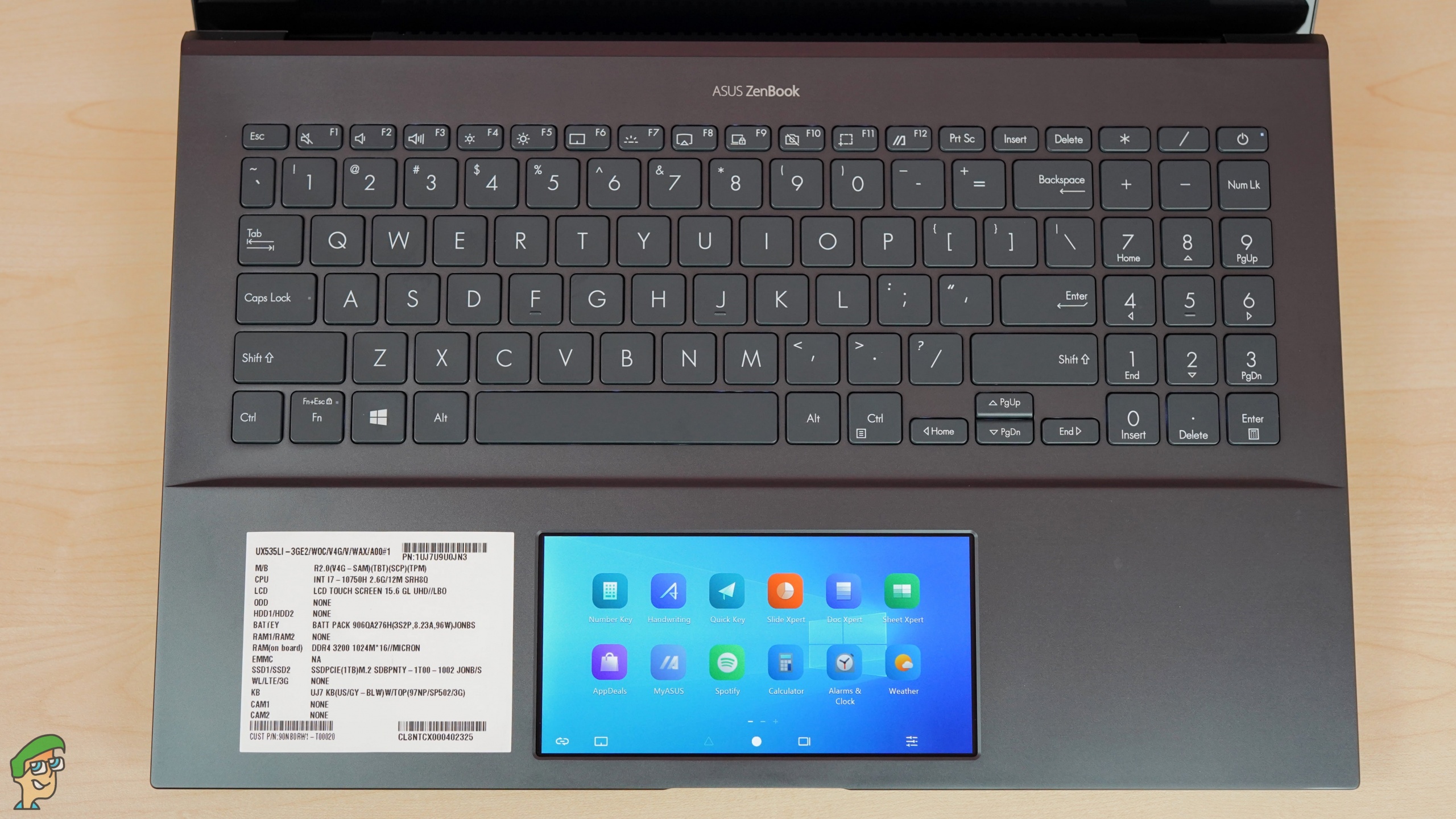
One of the most unique features of the ZenBook-series laptops is the presence of Screen-Pad, which is just like a screen that is present at the location of the touch-pad and it greatly enhances the functionality of the laptop. You can use the Screen-Pad for various kinds of functions like App-switcher, Mode-switch, Task Group, Handwriting, etc. and it is very handy at times.
Phone Call Function and Phone Screen Mirroring Function
This Screen-Pad with Screen-Xpert 2.0 includes a link to MyASUS function shortcut key on the far left of the navigation bar. This allows the user to call other people from the laptop using the Phone Call function and also allows the users to mirror the mobile on the laptop, where you can view the mobile screen clearly, although you cannot use the phone directly through the mirrored screen.

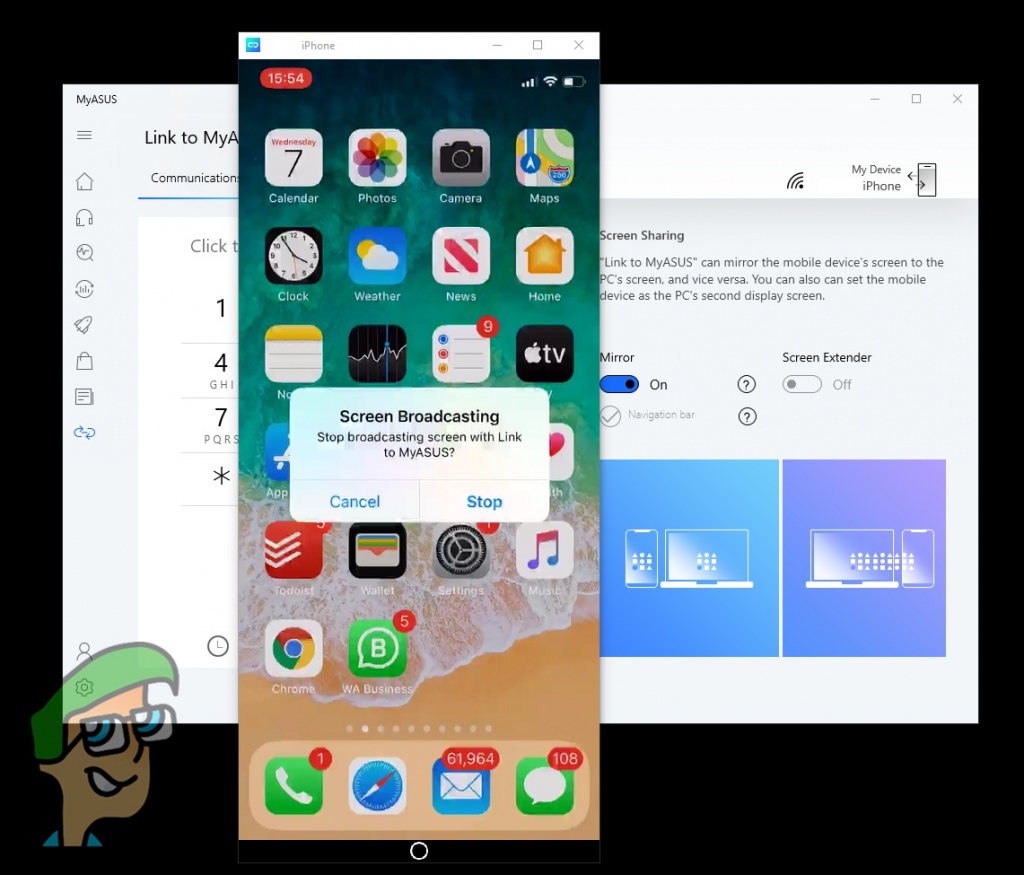
Methodology For In-Depth Analysis
The technical specifications of ASUS ZenBook Pro 15 are quite high and that is why we were very interested to see the performance of this laptop in various kinds of workloads. So, we have done a lot of tests on the laptop to help you in order to judge the performance of the laptop. We have performed the tests under the stock conditions and temperatures and have not used any cooling pad which would affect the judgement of a daily user.
We used Cinebench R15, Cinebench R20, CPUz, GeekBench 5, PCMark and 3DMark for the CPU performance; AIDA64 extreme for the stability of the system and thermal throttling; 3DMark and Unigine Superposition for the graphics tests; and CrystalDiskMark for the SSD drive. We checked the parameters of the hardware through the CPUID HWMonitor.
For checking the performance of the display, we have used Spyder X Elite and performed the full calibration test, screen uniformity test, colour accuracy test, brightness and contrast test, and the gamut test.
For checking the noise levels of the laptop, we placed a microphone at 20 cm away at the rear side of the laptop and then checked the reading for both idle and load setup.
CPU Benchmarks
This is the first of laptops that have come with Intel Core i7-9750H and this hexa-core processor is much better at handling high-end workloads. The cooling solution of this laptop is much better than what you would find in ultrabooks and that is why the processor keeps high frequency while keeping the temperatures under 80 degrees.
The laptop has a TDP of 45 watts but during full load, the power consumption of the processor went as high as 71 watts, where all the cores of the processor were running at 4200 MHz. The clock rates do reduce once the temperatures go above 75 degrees and we have thoroughly written about the thermal throttling of the processor in the section after the benchmarks.
[table “111” not found /]In the Cinebench R15 benchmark, the performance of the processor is not very different from the Coffee Lake series processors because these processors are also based on the 14nm process. The single-core score of 191 points is quite good for single-threaded applications while the multi-core score of 965 points is more than a stock desktop Intel Core i7-7700K, which is not too shabby for a mobile processor. The benchmark resulted in an MP ratio of 5.04 which means that the single-core performance of the processor is higher than the performance of a single core during the multi-core test.
The behaviour of the processor for the Cinebench R20 benchmark was slightly different. The processor got an impressive single-core score of 460 points, while in the multi-core test, it got 2139 points, leading to an MP ratio of 4.65, which is a bit low for a hexa-core processor.
ASUS ZenBook UX535LI Single/Multi-Core Performance GeekBench
| Single-core Performance | Multi-core Performance | ||
|---|---|---|---|
| Single-core Score | 1218 | Multi-core Score | 4931 |
| Crypto | 1619 | Crypto | 3553 |
| Integer | 1141 | Integer | 4957 |
| Floating Point | 1318 | Floating Point | 5105 |
In the Geekbench benchmark, the multi-core performance of the Intel Core i7-10750H dropped even lower. With a single-core score of 1218 and a multi-core score of 4931, the MP ratio of 4.04 is unexpectedly low for a hexa-core processor with Hyper-Threading and that is probably due to much lower multi-core clock rate than the single-core clock rate.
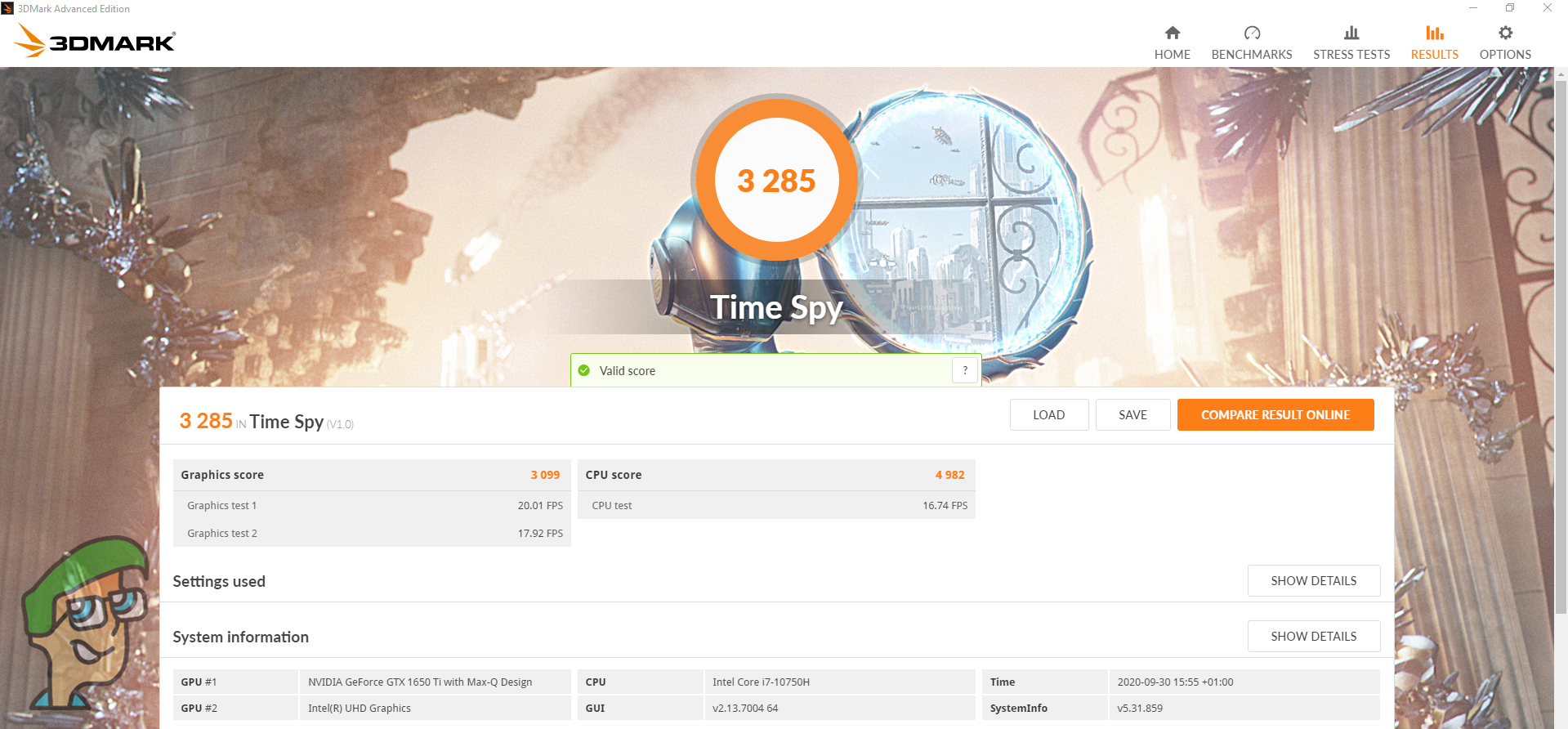
The performance of the processor in the 3DMark Time Spy benchmark is relatively better than the score in the Cinebench and GeekBench benchmarks and the CPU achieved a score of 4982 and FPS of 16.74. For reference, Intel’s octa-core flagship mobile CPU from the 9th generation, the Core i9-9880H scored 7221 points in the Time Spy test.
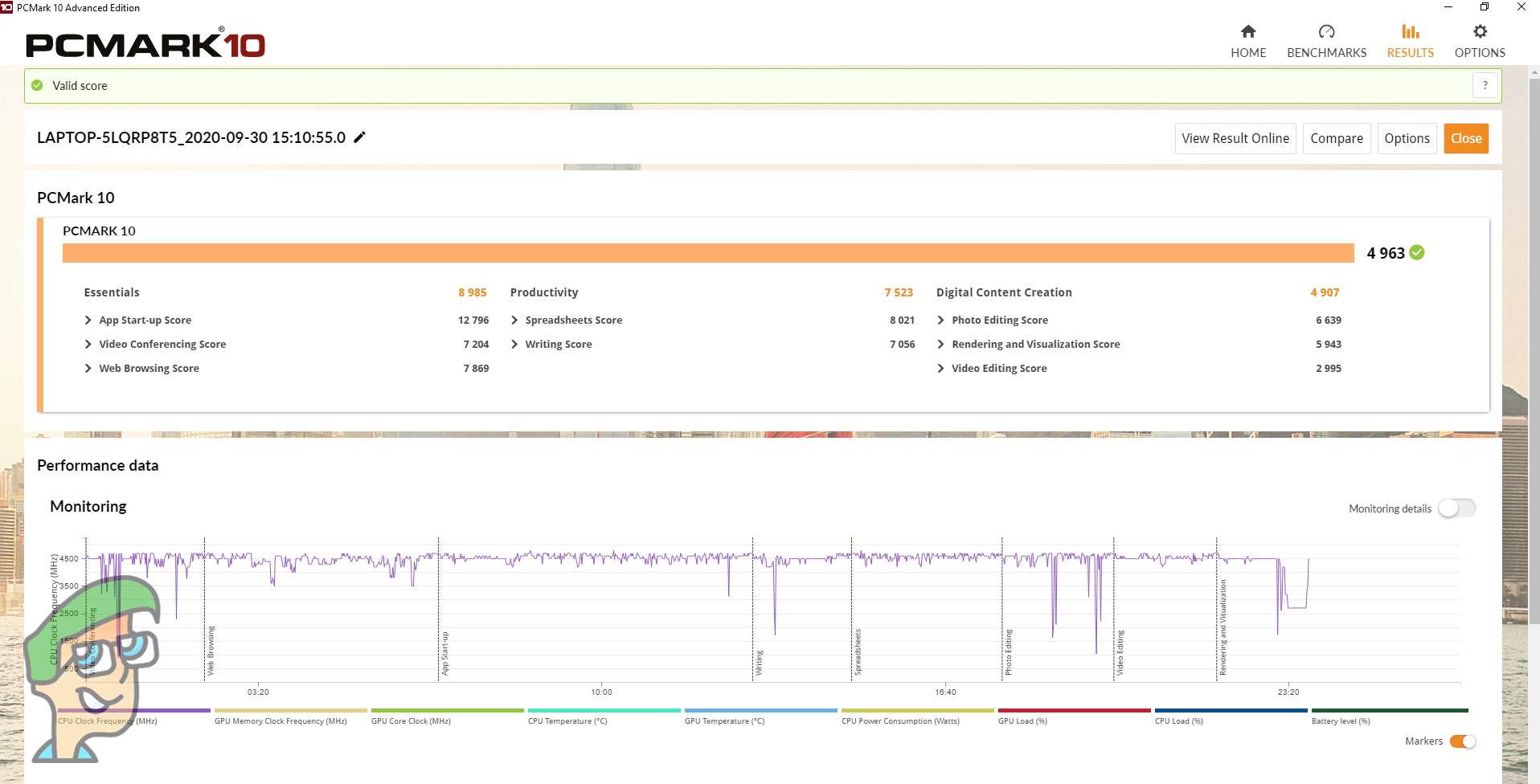
The performance of the processor in the PCMark10 is given above. The performance of the processor is not as high as the latest mainstream mobile processors by Intel whose single-core performance is faster.
The benchmarks of the CPU end here. Overall, there is a little to no improvement in performance against the last-generation Intel processors and faster multi-core clocks, possibly with a better cooling solution, might have improved the results.
GPU Benchmarks
ASUS ZenBook UX535LI uses NVIDIA GeForce GTX 1650 Ti Max-Q graphics card and we checked the performance of this graphics card with two benchmarks; 3DMark Time Spy benchmark and Unigine Superposition benchmark.

We checked the performance of the graphics card with 3DMark Time Spy benchmark. The graphics card achieved a score of 3285 points, with 20.01 FPS in the first graphics test and 17.92 FPS in the second graphics test. This score is almost half as that of a GeForce RTX 2060 mobile graphics card, which makes it an entry-level graphics card for gaming or other graphical applications.
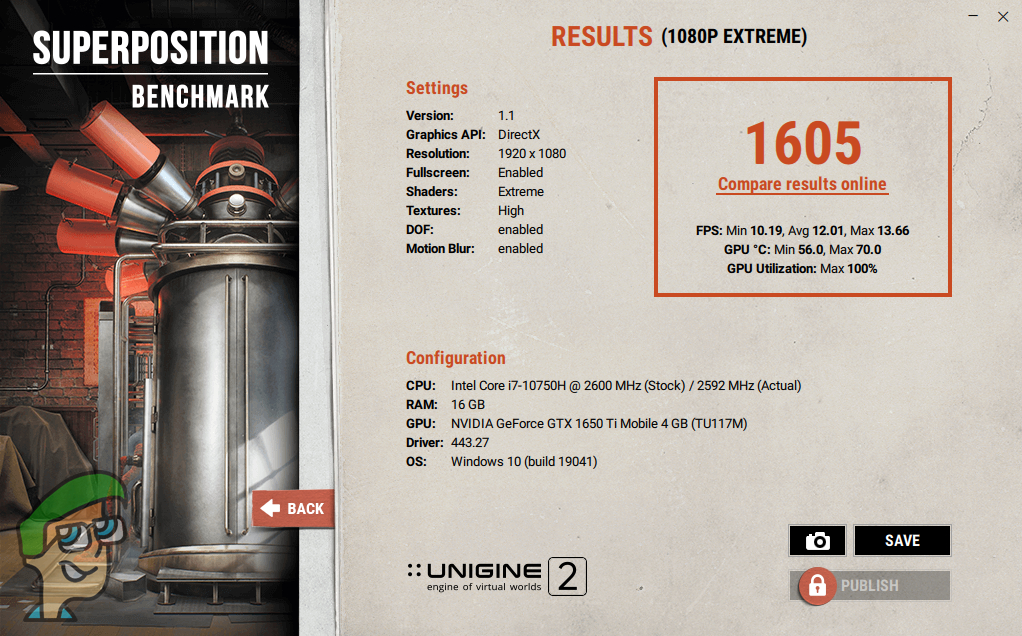
For the graphics card, the second test we did is the Unigine Superposition benchmark and the graphics card scored 1605 points on this benchmark. This score is more than two times slower than an RTX 2060 mobile graphics card.
Display Benchmarks
ASUS ZenBook UX535LI came with 4K IPS display without the touch capabilities and we tested the laptop with Spyder X Elite while the software application version used was SpyderXElite 5.4.

As you can see in the above picture, the gamma of the screen was somewhat above the mark before calibration, at 2.30 but after the full calibration, it reached 2.23, which is much closer to the perfect 2.20 value. The blacks at 0.33 seem impressive and the whites at 422 are excellent for 100% brightness levels. This roughly equates to around 1278:1 static contrast ratio, which is more than the common 1000:1 that you would find in most laptops.
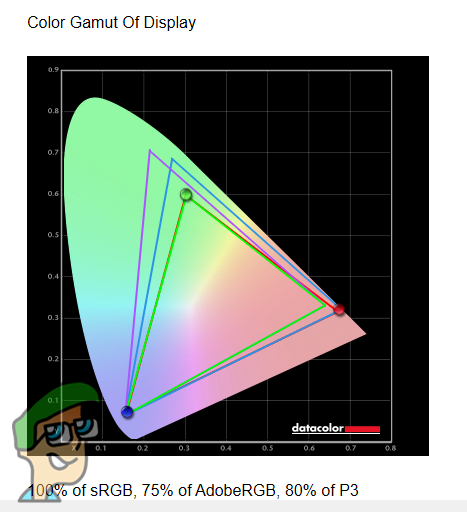
This screen is similar to some of the mid-range desktop screens, as it provides a 100% sRGB colour gamut, 75% of AdobeRGB, and 80% of DCI-P3 colour gamut.
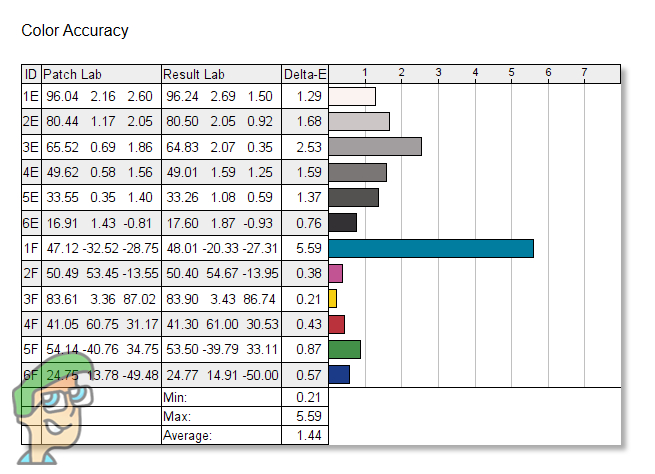

The colour accuracy of the laptop before calibration was better than even many entry-level professional screens, at 1.44 and with calibration, it got improved to 1.12, which is a really good result for a laptop screen.

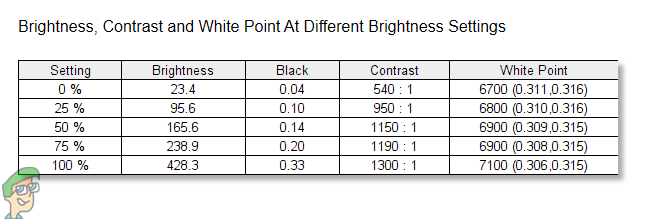
The above pictures show the brightness and contrast of the display for various brightness levels. The static contrast ratio decreased from 1370:1 to 1300:1 with calibration. This contrast ratio is better than many of the desktop screens priced around 200 to 300 bucks.
The above test shows the screen uniformity of the panel and as you can see, the performance of this display is not so good in this test. We saw a maximum deviation of over 13.6% in the bottom left corner, which is not the best scenario but definitely better than the entry-level laptop screens.
Overall, this 4K display provides crispy graphics for both watching videos and for doing productive works, although if you want to do colour-critical work, it will be better to buy the laptop with OLED 4K screen as that one has a much better contrast ratio and colour gamut.
SSD Benchmarks
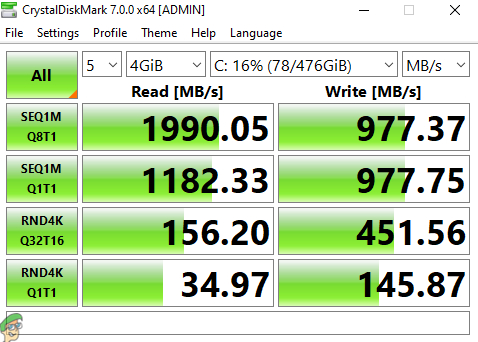
ASUS has used Western Digital PC SN730 SSD in this laptop having a capacity of 1024 GB. We used CrystalDiskMark benchmark for testing the performance of this SSD and the statistics can be seen in the picture. We did the 5 times repetition with 4GiB test.
The scores of the SSD seem shockingly great, especially the write speed seems unexpectedly high. Even the SEQ1M Q1T1 result seemed superb and the read speed in the RND4KK Q32T16 is noticeably higher than Kingston OEM SSDs.
Battery Benchmark
The battery timing of ASUS ZenBook Pro 15 UX535LI is terrific and we were amazed by the battery of this laptop. The laptop came with a 96 WHr 3-cell lithium-polymer battery and we did three tests with the laptop; first, we checked the battery timing of the laptop in the idle state till the battery got depleted, then we checked the battery timing with 4K video playback till the battery was drained and then at the last, we checked the battery timing of the laptop with Unigine Superposition game mode test and ran it till the laptop got shutdown.
The laptop lasted more than 24 hours in the idle state, which is a tremendous battery timing even for the idle state. As for the 4K video playback, it lasted around 10 hours. The battery timing of the laptop in rendering was a lot less than other tests, as the laptop uses a dedicated graphics card and it lasted around two hours.
Thermal Throttling
ASUS ZenBook Pro 15 UX535LI comes with a high-end cooling solution since it has a high-end processor and an entry-level dedicated graphics card as well and we tested the thermal throttling of the laptop with AIDA64 Extreme stability test and Furmark while keeping a check on the temperatures and other parameters via CPUID HWMonitor. The test was performed at an ambient temperature of around 30 degrees.
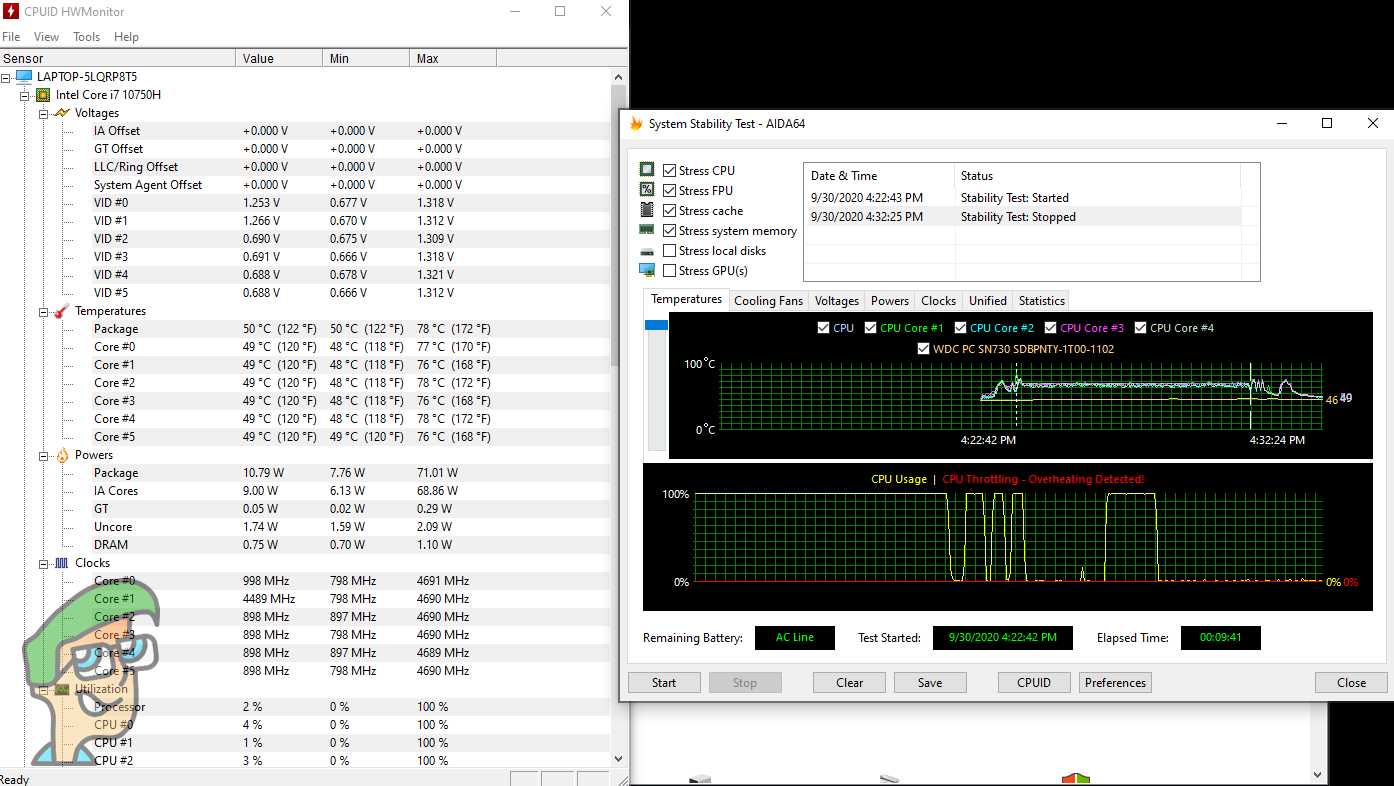
First, we stressed the CPU with AIDA64 Extreme and as the test started, all the cores had a clock rate of 4200 MHz but once the temperatures started going above 75 degrees, the clocks started to decrease and they went as low as 3000 MHz and at this point, the power consumption of the CPU was around 45 watts. These are the stable clock rates of the processor and the power consumption of the CPU is the same as its TDP, i.e. 45 watts.
Now, after the first testing, we stressed the graphics card alone with Furmark. The graphics card did not suffer from any thermal throttling at all and stayed under 70 degrees. The clock rates of the CPU started decreasing after the temperature went above 80 degrees and the thermals went as high as 90 degrees. The CPU clocks got stable at around 3700 MHz.
At last, we stressed the CPU and GPU both with AIDA64 Extreme and Furmark. This too, did not create any thermal throttle in the graphics card, although the processor started to suffer badly and the temperatures went above 90 degrees, so it had to compensate for the increase in temperature by decreasing the clocks. Finally, the clock rates of the CPU got stable at around 2000 MHz, where the power consumption of the CPU got to around 24 watts from the previous 45-watt mark.
Acoustic Performance / System Noise
For testing the noise of the laptop, we placed the microphone 20 cm away from the laptop at the rear side and checked the readings for both the idle state and the load state. The ambient noise level of the room was around 32.5 dB. For the idle state, we got a low reading of 34 dB while at full load, we checked the reading of the laptop after the AIDA64 Extreme stress test ran for around 5 minutes and the reading was 37 dB, which is much quieter than other laptops.
Conclusion
ASUS ZenBook Pro 15 is surely a great mid-range laptop that is aimed towards business-class people and those who are interested in a classy product. The technical specifications of the laptop are great for handling both graphical and non-graphical workloads, thanks to the hexa-core processor and dedicated graphics card. The physical design of the laptop is quite robust and it provides the laptop with marvellous looks while optimizing the cooling performance as well.
The unique hardware features of the laptop like the Screen-Pad tend to create a new standard in the industry while the software enhancements like Phone Call feature extend the functionalities of the laptop. The choice in the display panel gives the user a wide choice whether he wants to do colour-critical work or focus on the daily chores, so as not to burden everyone with the increased costs of the professional display panel.
Overall, if you are in need of an innovative product that can revolutionize your way of working and provide high performance while keeping the price under control, ASUS ZenBook Pro 15 UX535LI is the best thing you can get and there is no denying this fact.
ASUS ZenBook Pro 15 UX535LI
Best Mid-range Professional Laptop
Pros
- Available with great-quality screens
- Presence of a dedicated graphics card
- Screen-Pad definitely feels handy
- Phone Mirroring functionality seems awesome
Cons
- The processor's performance is limited by the cooling solution
Processor: Intel Core i7-10750H | RAM: 16GB DDR4 | Storage: 1TB PCIe SSD | Display: 15.6-inch 4K IPS panel | GPU: NVIDIA GeForce GTX 1650 Ti Max-Q

VERDICT:ASUS ZenBook Pro 15 is a great mid-range professional-class laptop that tends to become a daily driver due to unique functionalities that people are unable to find in other laptops.
Price at the time of review: N.A. (USA) and N.A. (UK)

 Check Price
Check Price




